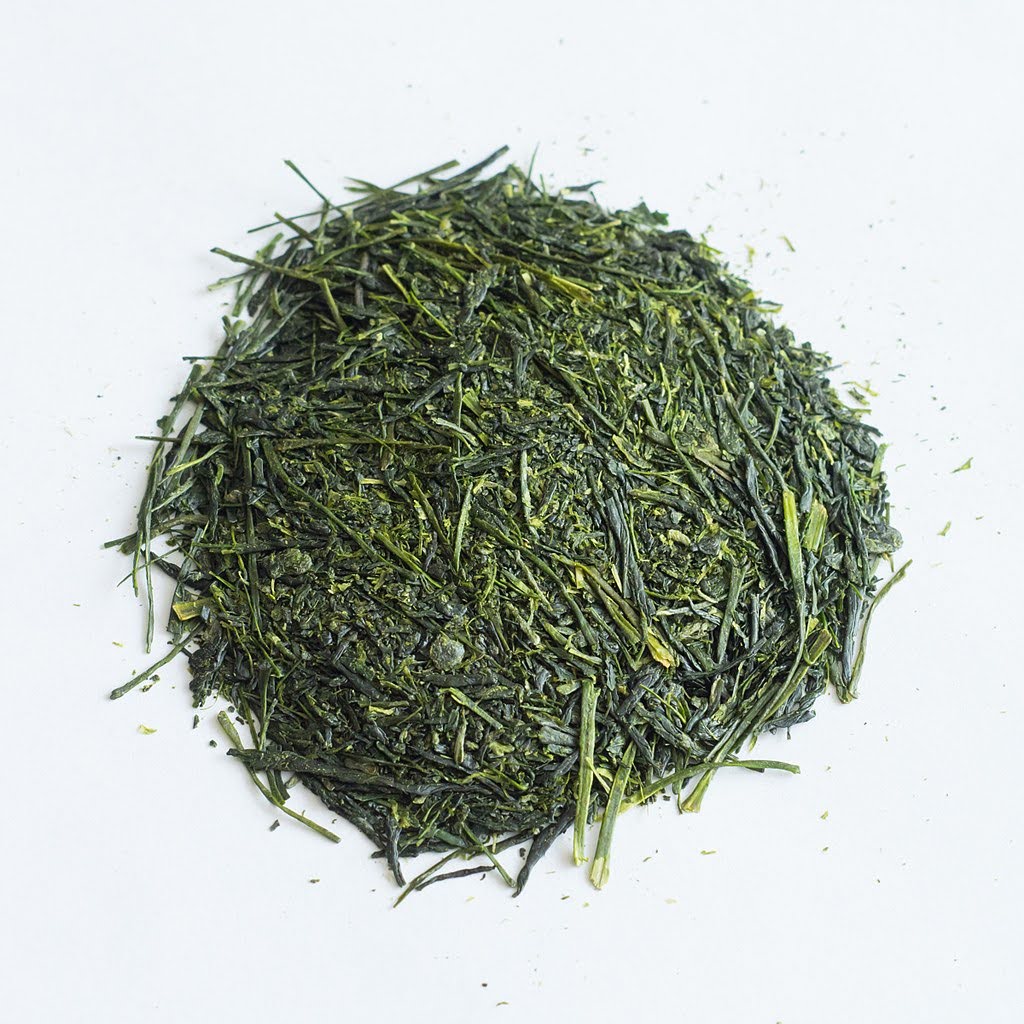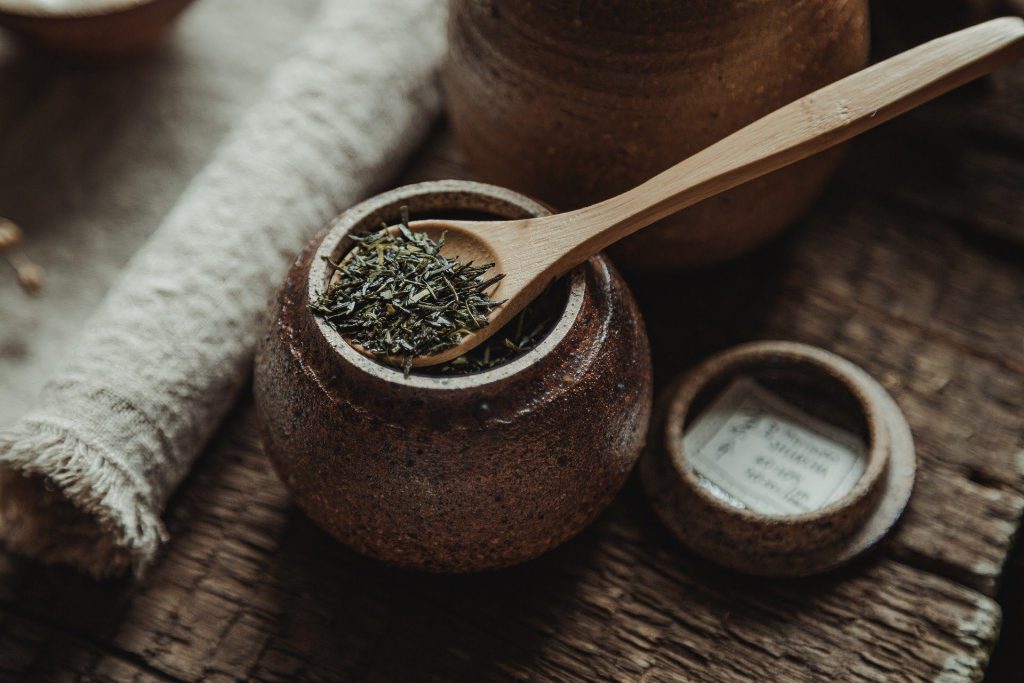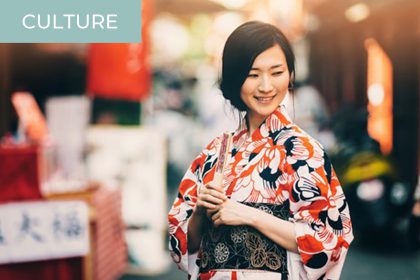In Japan, 99.9 percent of the tea produced is green. All the famous Japanese teas, such as sencha, gyokuro, and hōjicha, are green teas. So what is the difference between all the tea varieties from Japan?
This article was kindly provided to Kokoro Media by our partner the German-Japanese Association in Munich (Deutsch-Japanische Gesellschaft (DJG) München), and was originally published in the association’s newsletter, Kaiho July/August 2021. Written and translated from German to English by Jeanne-Rose Therre-Ohlig. ]
What is “Green Tea”?
“Green tea” means tea that has not been fermented (a term that actually refers to oxidation). What Westerners call “black tea” is actually fermented (oxidized) tea; oolong tea is a semi-fermented tea.
In short, to make green tea, the oxidation of the tea leaves must be stopped as soon as possible after harvesting. To do this, the tea leaves must be heated. The most widespread technique in the world today, especially in China, is to heat the tea leaves by bringing them into direct contact with a heated surface, as if they were in a large frying pan.
What is special about Japanese green tea, however, is that the tea leaves are heated with water vapor. After plucking, the tea leaves are steamed. This technique originated in China, where it largely disappeared a few centuries ago.
There are three to four harvests in Japan, but only the first one, which takes place between the end of March and the middle of May, depending on the area, produces Japanese green tea of very high quality.
Sencha

Sencha is the most common type of Japanese green tea, accounting for almost 70% of the tea produced in Japan. It is produced almost everywhere in Japan and the range of Sencha is very wide, from very inexpensive to the most luxurious tea leaves. Sencha is believed to have been invented in 1738 by Nagatani Sōen in Uji, Kyōto. This makes it relatively new in the history of tea in Japan. The real development of sencha began in the second half of the 19th century, when it became an important export, especially to the United States. At that time, tea was Japan’s second-largest export, after silk!
The freshly picked tea leaves are brought to the factories, where they are steamed as quickly as possible to prevent oxidation. The tea leaves are then rolled and dried in several steps to remove the moisture and give the leaves their characteristic needle shape. Regardless of the type of tea, rolling the leaves results in a quick infusion, but is also an essential step in ensuring that the tea leaves dry well.
Drying of the tea leaves, the producer’s work ends with a drying phase that results in a product with a moisture content of about 5%.
At this point, the tea is still considered an unfinished raw material, called “Ara-cha“. Ara-cha is sold to tea wholesalers. The wholesalers put the finishing touches on the tea to make it Sencha. The tea leaves are sorted: twigs, powder, and buds are removed. Then comes the “hiire“, the final drying, which leaves about 3 % moisture in the leaves. The drying has a decisive influence on the taste of the tea. In some cases, the tea is blended and finally packaged.
When talking about Japanese green tea, we often refer to futsū-mushi sencha (or asamushi sencha) and fuka-mushi sencha. The former refers to sencha made by the traditional method of steaming it for 30 seconds. Generally, this produces a tea with a clear yellow-green liquid and a fragrant, subtle flavor. The latter refers to sencha that is steamed for longer, between 45 seconds and 2 minutes. The result is more broken leaves and a tea with a deep green liquid. Its flavor is stronger, but it has less fragrance.
Gyokuro

Gyokuro is a high-quality Japanese green tea. Really good gyokuro is expensive because of the way the tea leaves are grown. Gyokuro is also brewed in a very special way, but most people are not aware of this. Less than 1% of Japanese tea production is Gyokuro. It is mainly produced in Kyōto and Fukuoka prefectures, although tiny amounts are also produced in Shizuoka. There are many theories about how it was discovered, but it seems that it emerged in the first half of the nineteenth century in Uji, Kyōto Prefecture.
The processing of this Japanese green tea is not fundamentally different from that of sencha; the key to gyokuro lies in the way it is grown. Gyokuro is grown in the shade. The plantation is covered 20 days before the day on which the tea leaves are to be picked. This produces tea leaves that are particularly rich in theine, the amino acid responsible for the sweetness of the tea. The scent characteristic of Japanese green teas from covered plantations is known as “Ooi-ka“. This Japanese green tea is drunk in very small quantities, but properly infused, its flavor is very strong, smooth, and complex.
Kabusecha

Like gyokuro, kabusecha tea is also grown in the shade. However, the shading period is different and shorter, only about 10 days. In addition, the shading method is simpler. Depending on the length of the shading period and the shading method, kabusecha is more or less similar to sencha or gyokuro. Kabusecha lies between these two types of Japanese green tea. It is grown in many areas, but the largest growing area for kabusecha is Mie Prefecture.
Tamaryokucha

“Tamaryokucha” refers to two very different types of Japanese green tea, which account for about 3% of Japanese production. The first dates back to a very ancient time and was probably imported from China in the sixteenth century. It is commonly called kama-iricha (although its official name is kama-iri sei tamaryokucha). It is made by the Chinese method, which means that oxidation is prevented by heating the tea leaves in direct contact with a pan. It is much stronger than sencha and was also the first tea to be brewed in a teapot in Japan.
Today, kama-iricha is very rare and is mainly produced on the large southern island of Kyūshū. The tea has a light, refreshing flavor and is especially appreciated for its special fragrance, known as “kama-ka“.
In the 1920s, another type of tamaryokucha appeared in Japan. It is commonly called “guricha” (its official name is mushi-sei tamaryokucha). In reality, it is not much different from sencha, except that it does not go through the rolling stage that gives sencha leaves (and gyokuro and kabusecha) their needle shape. The result is therefore twisted, hook-shaped tea leaves. This makes the tea look a little like kama-iricha, but the taste is very close to sencha. Originally, guricha was intended for export to the Middle East.
Today, the main cultivation area for guricha is in Kyūshū, especially in Saga Prefecture (ureshino tea), but it is also a speciality of the Izu Peninsula in Shizuoka Prefecture. In general, “tamaryokucha” almost always refers to unrolled tea that has been steamed, while the pan-fried version is almost always called “kama-iricha”.
Tencha (Matcha)

Matcha is the powdered Japanese green tea used in the famous Japanese tea ceremony. It has a very ancient history, having been brought from China by the Zen monk Eisai. Matcha is obtained by stone-grinding a tea called tencha to make a powder. Tencha itself is almost never drunk as such. Like gyokuro, it is grown in the shade. The tea leaves are steamed and then dried. They are then processed to retain only the pulp, not the stems or veins of the leaves. Finally, when they are ground, they become matcha.
Bancha
With the exception of banchas, i.e. either low-quality senchas from late harvests or very rare regional teas, the other Japanese green teas are either variations of the teas described above or products created in the final stage of the production of other teas through sorting.
Hōjicha

Hōjicha is a Japanese green tea obtained by roasting bancha, sencha and even gyokuro tea leaves and stems. Despite its brown color, it is actually green tea as it is not fermented. Hōjicha is usually considered an everyday tea, but when made from high-quality raw material, it can also be a very fine gourmet tea.
Genmaicha
Genmaicha is made from sencha or bancha with the addition of roasted rice and sometimes even matcha.
Demono
Demonos are teas that result from sorting during the production of sencha and gyokuro. Konacha is made from powder, mecha from small bud pieces and kukicha from stems. A tea made from gyokuro stems is called “karigane”. In a sense, then, these teas are “by-products” and relatively inexpensive. Nevertheless, their quality varies greatly. A demono made from sorting an inferior sencha is of poor quality, while demono made from sorting a good gyokuro is of much better quality.
Tea Production Areas in Japan

Tea is grown everywhere in Japan, except on the northern island of Hokkaidō and in the greater Ōsaka area. In some prefectures, however, tea is not grown commercially. The northernmost prefecture where tea is grown commercially is Niigata, where murakami tea is produced.
Nevertheless, only a handful of tea-growing areas are known to the public. First, Shizuoka Prefecture is the leading tea-growing area in Japan. About 40 percent of Japan’s tea plantations are in Shizuoka. Shizuoka and Uji in Kyōto Prefecture are also the best-known tea-growing areas. However, Kyōto Prefecture is only seventh in terms of the number of plantations (with only three percent of Japan’s total).
The second-largest tea-growing area in Japan is Kagoshima on the southern island of Kyūshū. It accounts for 20 percent of Japan’s plantations. Although tea from Kagoshima is still unknown to many, it is becoming increasingly popular thanks to the use of many different tea plant varieties, which has led to a wide range of different flavors. Also on the island of Kyūshū are Miyazaki, Kumamoto, and Fukuoka, the fourth, fifth, and sixth largest tea producers. While Fukuoka is very well known for its yam tea, Miyazaki and Kumamoto are still relatively unknown, although they produce very high-quality tea.
Finally, another famous tea-growing area should be mentioned: Saitama Prefecture, north of Tōkyō. Tea from Saitama enjoys great popularity in the capital region, even though production is constantly declining.
The widely used Japanese tea, sencha, is produced wherever tea is grown. However, almost all gyokuro is produced in Kyōto (uji tea) and Fukuoka (yame tea). Mie Prefecture (little known, although it is the third largest tea growing area) specializes in kabusecha. Tamaryokucha is mainly produced in Kyūshū.
Of course, the land and soil in each area influence the taste of the tea, but cultivation techniques and breeds are also crucial factors in the wide variety of flavors and fragrances of Japanese tea.
Source: https://www.thes-du-japon.com/index.php?main_page=page&id=4
| Variety | Characteristics & producing regions |
| Sencha (53.6 % of production) | Most popular tea variety. Processed by steaming, kneading and drying new shoots. Produced in all Japanese regions |
| Gyokuro (0,3 % of production) | Cultivated under a sun-protecting cover of straw or tana (blanket shelf) for about 20 days before harvest. Processed in the same way as sencha. Produced in Kyōto and Fukuoka. |
| Kabusecha (4,2 % of production) | Cultivated under a sun-protecting cover of straw or tana for about a week before harvest. Processed in the same way as sencha. Produced in Mie and Fukuoka. |
| Tencha (Matcha) (4,4 % of production) | Cultivated under a sunshade for three weeks to one month before harvesting (i.e. longer than gyokuro). Processed by drying the tea leaves without kneading. Matcha is a powdered tea made by grinding tencha with a stone mill. Produced in Kyōto, Aichi, and Kagoshima. |
| Tamaryokucha (2,5 % % of production) | Unlike sencha, tamaryokucha is not trimmed, so the tamaryokucha leaf is round. Produced in Kumamoto, Saga and Nagasaki. |
Source: Japanese Association of Tea Production (https://www.maff.go.jp/e/policies/agri/attach/pdf/tea_202012.pdf)




